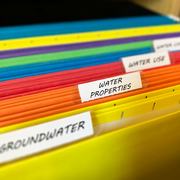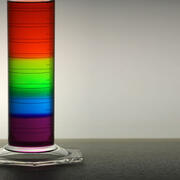Water Compressibility
Water is essentially incompressible, especially under normal conditions. Yet, in industrial applications water can be tremendously compressed and used to do things like cut through metal.
• Water Science School HOME • Water Properties topics •

Credit: Joe Mabel
It is hard to "put the squeeze" on water
Water is essentially incompressible, especially under normal conditions. If you fill a sandwich bag with water and put a straw into it, when you squeeze the baggie the water won't compress, but rather will shoot out the straw. If the water compressed, it wouldn't "push back" out of the straw. Incompressibility is a common property of liquids, but water is especially incompressible.
Water's lack of compressibility helps to push water out of water hoses (handy for putting out fires), water pistols (handy for bothering Dad), and in artistic water fountains (handy for relaxing). In these instances, some pressure is applied to a container full of water and rather than compress, it comes shooting out of an opening, such as the end of the hose or the end of a small pipe, as in this fountain. If water was highly compressible, it would be harder to create enough pressure for water to shoot out of the nearest opening
Kids make good use of water's uncompressibility when they play a game of water-balloon tossing. When you squeeze the balloon too much, the balloon's skin will fail before the water inside compresses—it will burst in your face long before the water will compress even an infinitesimal amount.
Water compressibility experiment
When I was 7 years old, water's incompressibility got me in big trouble. I was analyzing the compressibility of water by soaking a sponge with water, smushing it up, and watching how much water came back out. To test if water compressed, I added some red food color to the water, soaked it up, and sat on my parent's new white carpeting to prove my theorem. I thought that since water was trapped in the sponge, I could squeeze the sponge and the water would compress. My theorem was (painfully) disproved, as the water squirted out rather than compress. Well, I was a kid, how was I to know that the compressibility of water at room temperature is only about 0.000053 for an increase of about 14.7 pounds per square inch in pressure?
Pressure and temperature can affect compressibility
But, squeeze hard enough and water will compress—shrink in size and become more dense ... but not by very much. Envision the water a mile deep in the ocean. At that depth, the weight of the water above, pushing downwards, is about 150 times normal atmospheric pressure (Source: University of Illinois at Urbana-Champaign Ask the Van). Even with this much pressure, water only compresses less than one percent.

Credit: Steve Brown Photography
Yet, in industrial applications water can be tremendously compressed and used to do things like cut through metal (especially if an abrasive material is added to the water and the water is hot). Water being pushed out at tremendous speed through a tiny hole is used in industry to cut through everything from metal to ceramics to plastics and even foods. It is the preferred method when the materials being cut are sensitive to the high temperatures generated by other methods. It has found applications in a diverse number of industries from mining to aerospace where it is used for operations such as cutting, shaping, carving, and reaming. Of course, to cut through stone a stream of water must be moving very fast and producing a tremendous amount of pressure. A pump is used to pressurize water in a container at pressure values up to 90,000 pounds/square inch (psi) and then shoot it out of the nozzle at speeds up to 600 mph. (Source: NASA).
Below are other science topics associated with the compressibility of water.
Water Properties Information by Topic
Water Density
Below are multimedia items associated with the compressibility of water.
Below are publications associated with the compressibility of water.
The compressibility of liquids The compressibility of liquids
Water is essentially incompressible, especially under normal conditions. Yet, in industrial applications water can be tremendously compressed and used to do things like cut through metal.
• Water Science School HOME • Water Properties topics •

Credit: Joe Mabel
It is hard to "put the squeeze" on water
Water is essentially incompressible, especially under normal conditions. If you fill a sandwich bag with water and put a straw into it, when you squeeze the baggie the water won't compress, but rather will shoot out the straw. If the water compressed, it wouldn't "push back" out of the straw. Incompressibility is a common property of liquids, but water is especially incompressible.
Water's lack of compressibility helps to push water out of water hoses (handy for putting out fires), water pistols (handy for bothering Dad), and in artistic water fountains (handy for relaxing). In these instances, some pressure is applied to a container full of water and rather than compress, it comes shooting out of an opening, such as the end of the hose or the end of a small pipe, as in this fountain. If water was highly compressible, it would be harder to create enough pressure for water to shoot out of the nearest opening
Kids make good use of water's uncompressibility when they play a game of water-balloon tossing. When you squeeze the balloon too much, the balloon's skin will fail before the water inside compresses—it will burst in your face long before the water will compress even an infinitesimal amount.
Water compressibility experiment
When I was 7 years old, water's incompressibility got me in big trouble. I was analyzing the compressibility of water by soaking a sponge with water, smushing it up, and watching how much water came back out. To test if water compressed, I added some red food color to the water, soaked it up, and sat on my parent's new white carpeting to prove my theorem. I thought that since water was trapped in the sponge, I could squeeze the sponge and the water would compress. My theorem was (painfully) disproved, as the water squirted out rather than compress. Well, I was a kid, how was I to know that the compressibility of water at room temperature is only about 0.000053 for an increase of about 14.7 pounds per square inch in pressure?
Pressure and temperature can affect compressibility
But, squeeze hard enough and water will compress—shrink in size and become more dense ... but not by very much. Envision the water a mile deep in the ocean. At that depth, the weight of the water above, pushing downwards, is about 150 times normal atmospheric pressure (Source: University of Illinois at Urbana-Champaign Ask the Van). Even with this much pressure, water only compresses less than one percent.

Credit: Steve Brown Photography
Yet, in industrial applications water can be tremendously compressed and used to do things like cut through metal (especially if an abrasive material is added to the water and the water is hot). Water being pushed out at tremendous speed through a tiny hole is used in industry to cut through everything from metal to ceramics to plastics and even foods. It is the preferred method when the materials being cut are sensitive to the high temperatures generated by other methods. It has found applications in a diverse number of industries from mining to aerospace where it is used for operations such as cutting, shaping, carving, and reaming. Of course, to cut through stone a stream of water must be moving very fast and producing a tremendous amount of pressure. A pump is used to pressurize water in a container at pressure values up to 90,000 pounds/square inch (psi) and then shoot it out of the nozzle at speeds up to 600 mph. (Source: NASA).
Below are other science topics associated with the compressibility of water.
Water Properties Information by Topic
Water Density
Below are multimedia items associated with the compressibility of water.
Below are publications associated with the compressibility of water.



